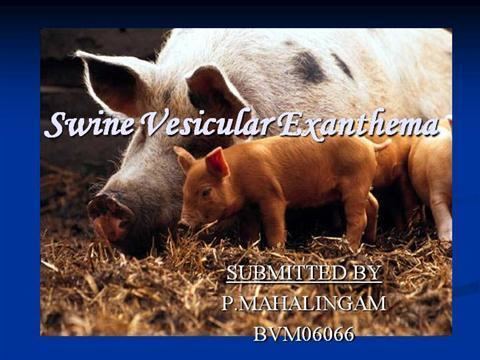Group Group IV ((+)ssRNA) | Rank Species | |
 | ||
Similar Vesivirus, Caliciviridae, Lagovirus, Senecavirus, Sapovirus | ||
Medical vocabulary what does vesicular exanthema of swine virus mean
Vesicular exanthema of swine virus (VESV) is a virus different from those causing Foot-and-Mouth Disease (FMD) and Swine Vesicular Disease (SVD) but it produces a disease in pigs that is clinically indistinguishable from FMD and SVD. Unlike FMD it only affects pigs.
Contents
- Medical vocabulary what does vesicular exanthema of swine virus mean
- Source of virus
- History
- Transmission
- Symptoms
- Zoonosis
- Diagnosis
- Morphology
- Physical chemistry and Physical Property
- Nucleic Acid
- Proteins
- Lipids
- Genomic organization and Viral replication
- Management control and prevention
- References
Currently, VESV is only a concern among Californian pig-farmers, otherwise, the disease is now, by and large, a historical curiosity. It was globally eradicated in swine in 1959.
Source of virus
Viruses that are virtually identical to VESV virus are present in marine mammals and fish along the Pacific coast of the USA. These viruses are sometimes called San Miguel Sea Lion Virus. It is therefore assumed that the source of VESV was waste sea food fed to pigs or as garbage finding its way to pigs from farmed-mink fed seafood.
History
VESV was first diagnosed in pigs in Southern California in 1932. Because of its close similarity to FMD all the pigs were destroyed. It kept reappearing in California from time to time, the pigs being slaughtered each time. Then in 1952 the virus escaped from California in a train-load of infected pork. Garbage fed pig herds came down with the disease and it spread from them to neighbouring herds until herds in 43 states were affected. It was eventually stamped out in 1956 by a major slaughter policy combined with a ban on feeding uncooked garbage to pigs. It was declared an exotic disease in the USA in 1959
The only cases outside the USA were in slaughter pigs on ships from the USA bound for Hawaii in 1947 and in pigs fed uncooked pork scraps from an American military base in Iceland in 1955.
The source of the virus remained a mystery until 1972 when an essentially similar virus the San Miguel Sea Lion Virus (SMSV) was isolated from San Miguel Island sea lions. When inoculated experimentally into pigs it caused typical signs of VESV.
Transmission
Once established within a herd, transmission from pig to pig is by direct contact. Initiation of new outbreaks starts by feeding infected uncooked pork scraps.
Symptoms
VESV does not affect cattle, sheep, goats or any species other than the pigs and marine mammals.
Mortality is low but there may be some deaths in suckling piglets. Growing pigs may become debilitated.
Zoonosis
VESV is not transmissible to humans.
Diagnosis
This is the same as for suspected FMD and SVD and requires laboratory tests to identify it. Serological methods such as complement fixation, serum neutralisation and PCR are available.
Morphology
Virions consist of a capsid. Virus capsid is not enveloped, round with icosahedral symmetry. The isometric capsid has a diameter of 35–39 nm. Capsids appear round to hexagonal in outline. The capsid surface structure reveals a regular pattern with distinctive features. The capsomer arrangement is clearly visible. Capsid with 32 cup-shaped depressions.
Physical chemistry and Physical Property
Under in vitro conditions virions are inactivated in acid environment of pH 3–5.
Nucleic Acid
The genome is not segmented and contains a single molecule of linear positive-sense, single-stranded RNA. Minor species of non-genomic nucleic acid are also found in virions. The complete genome is 7900 nucleotides long. The 5'-end of the genome has a viral protein genome-linked (VPg). The 3'-terminus has a poly (A) tract.
Proteins
The viral genome encodes viral structural proteins.
Lipids
Lipids are not reported.
Genomic organization and Viral replication
By itself, genomic nucleic acid is infectious.
